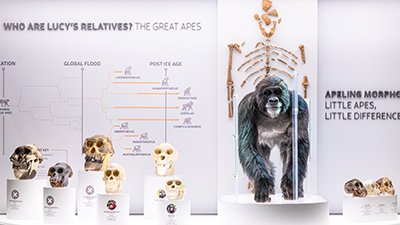
Laetoli Footprints Revisited
A second look at Laetoli still asks the wrong question.
News Source
- LiveScience: “Human Ancestor ‘Family’ May Not Have Been Related”
The Laetoli footprints are back in the news. Discovered in Tanzania in the 1970s by Mary Leakey below rock dated at 3.6 million years, the trail of tracks has classically been interpreted as the “first family” of upright-walking human ancestors. The tracks appear to belong to two individuals walking side by side and another behind. A presentation at the Society of Vertebrate Paleontology’s annual meeting has revealed new information showing the tracks may belong to four individuals who were not walking together.
The tracks have long been re-buried for their preservation, but last February a portion was re-excavated to evaluate the area for a future museum. Only casts of the prints have been available to study for many years. But now, modern high-resolution three-dimensional photography has produced high-quality pictures for scientists to reexamine. Researchers at the Bureau of Land Management studied those photos and presented their findings at the meeting in Las Vegas.
The 3-D views reveal an extra set of toe prints inside one set of the prints. Furthermore, all the prints are the same size, without a smaller set attributable to a juvenile as previously thought. “So instead of having three individuals of different sizes, with the sizes related to different ages, there are probably four individuals of the same size moving through this area, perhaps not traveling as a group,” paleontologist Brent Breithaupt explained.
So instead of having three individuals of different sizes, with the sizes related to different ages, there are probably four individuals of the same size moving through this area, perhaps not traveling as a group.
Until now “any secondary interpretations had to be made from the first interpretations or from a cast or reproduction,” Neffra Matthews added. “So not having access to that primary set of data kind of channeled the way the interpretations would go from then on.”
Denver paleontologist Martin Lockley, commenting on the study, pointed out how modern biases had crept into our interpretation of the famous footprints. He said, “There's a temptation to say, 'Well, we've got this data and it must mean something. And where do we get our meaning? We get our meaning from our cultural experience. So we say, ‘We've got happy families today, here's a family 3.5 million years ago.’ . . . The whole concept of the family, possibly two adults and a baby, it's kind of like the three bears: mama, papa and baby.”
While correctly pointing out that scientists do interpret fossil evidence through their own biases, Lockley doesn’t go quite far enough. The right question should not be “how many went for a stroll across the volcanic ash?” The real question for the evolutionist is “what were they?”
The Laetoli footprints are sandwiched between rock dated at 3.6 and 3.8 million years old by potassium-argon dating.1
Current evolutionary wisdom maintains the earliest Homo human ancestor evolved about 1.90 million years ago. (There was a 2.33 million year old candidate, but it recently lost face. Read more about it at Sediba with a Little Sleight of Hand.) Thus, the Laetoli footprints cannot be interpreted as human, since humans weren’t supposed to be around yet. Even if they look human!
Despite many evolutionists’ insistence that the footprints belong to an extinct human ancestral ape called Australopithecus afarensis, the footprints appear to belong to modern humans, albeit barefoot ones.
And in fact they do. Despite many evolutionists’ insistence that the footprints belong to an extinct human ancestral ape called Australopithecus afarensis, the footprints appear to belong to modern humans, albeit barefoot ones. “Lucy” was found in faraway Ethiopia, although some possible Au. afarensis mandibles were found around Laetoli. But apes are knuckle-walkers and, even when walking upright, leave tracks distinctly different from humans. The ape pelvis and musculature is such that an ordinary bipedal gait is impossible. Yet the Laetoli tracks show an ordinary human bipedal gait. The tracks also have ordinary human arches and, when examined by evolutionist R. H. Tuttle were found to be completely consistent with barefoot modern-type humans.
Controversy has raged about whether Lucy walked upright. Did “she” even have an arched foot? Yet thanks to dating dogma, even anatomical evidence that Lucy’s family could not have been bipedal carries no weight. The afarensis apes must have walked upright at Laetoli, proving themselves to be viable human ancestors, because humans at Laetoli would be the ultimate anthropological anachronism. The popular interpretation of Laetoli, to be enshrined in a new museum, is slavishly committed to the evolutionary worldview. Even the anatomical facts dare not fly in the face of the dating game.
The Bible tells a different story. In the Bible we learn from God’s own eyewitness account that He created animals on the sixth day of creation about 6,000 years ago. Then the same day He created Adam and Eve in His own image. Human beings did not evolve from apes or anything else. God made each kind of animal, as well as the first people, and designed them all to reproduce after their kinds. And even if a truly bipedal apelike animal with an arched foot and human-like stride had walked across Laetoli, that would not mean that humans evolved from bipedal apelike animals. A bipedal ape, if it existed, would just be an animal. But human beings are not animals. Human beings have a spiritual nature, and it is sinful human beings—descended not from apelike animals but from Adam—that Jesus Christ died to redeem.
Further Reading
For More Information: Get Answers
Remember, if you see a news story that might merit some attention, let us know about it! (Note: if the story originates from the Associated Press, FOX News, MSNBC, the New York Times, or another major national media outlet, we will most likely have already heard about it.) And thanks to all of our readers who have submitted great news tips to us. If you didn’t catch all the latest News to Know, why not take a look to see what you’ve missed?
(Please note that links will take you directly to the source. Answers in Genesis is not responsible for content on the websites to which we refer. For more information, please see our Privacy Policy.)
Footnotes
Recommended Resources

Answers in Genesis is an apologetics ministry, dedicated to helping Christians defend their faith and proclaim the good news of Jesus Christ.
- Customer Service 800.778.3390
- © 2024 Answers in Genesis



